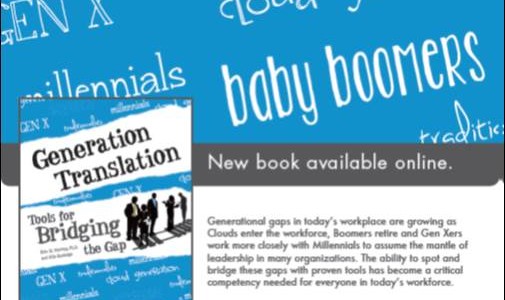Generation Translation: Are You Connecting?
Generational gaps between us in the workplace are growing in number and size. The ability to spot and bridge them has become a critical competency. Different generations each approach life, work and relationships from a distinct angle. Knowing that angle and how to predict and respond to it gives us each a decisive advantage.
There are currently four, soon to be five, generations leading and/or working side-by-side — Traditionalists, Baby Boomers, Generation X, Millennials, and Cloud Generation. Their outlooks, values, work styles and behavioral tendencies are frameworks for understanding how the events of our formative years may shape our work dispositions.
The Theory
Every generation forms a collective group that shares their same cultural hallmarks, a similar societal history, comparable defining moments, the same technology, and a shared attitude toward and reaction against the generation that came before it. People of the same age, therefore, are likely to have similar underlying value systems. These value systems are good predictors of workplace behaviors and expectations and provide us powerful insights on ourselves and each other.
There are many ways to introduce the dynamics and differences across and within the four generations in today’s workplaces. However, the one I’ve chosen may be the most costly in terms of strife and conflict — each generation’s preferred technology or media preferences for communicating/connecting with each other.
R U Connecting?
Today’s employees have access to many digital tools – for some, too many. As a result, communication flow and impact have dramatically improved. Or have they? It depends on your generational perspective. Obsession with digital connectivity has changed the nature of communication and given all of us far more options to reach out to others. Different generations tend to favor and rely on “their communication medium of choice.” Some might see “smart” communication devices as lacking a personal or private quality. Here are some differentiating insights:
- Traditionalists born between 1920 – 1946
Face to face contact was the norm for isolated lives in rural agrarian communities. Families gathered around the radio with mom or dad as the filter and listened to news for entertainment. High school degrees were rare and college degrees unlikely for the masses. Communicating always had a known human element to it – no anonymity.
- Baby Boomers born between 1947 – 1964
The “golden age” of TV provided passive and solitary entertainment. Boomers never saw a personal computer in high school or college. At work, information was scarce, expensive, institutionally oriented, and designed for passive use. Boomers value high proficiency in literacy – reading, spelling, grammar, writing, and basic math skills.
- Generation X born between 1965 – 1980
Generation X was shaped by a culture of gadgets and tools foremost among them, the PC — that delivered instant results. Thus, they value efficiency and used personal computers in college and on their first jobs. At work, information has always been abundant, cheap, personally oriented and designed for making quick decisions.
- Millennials born between 1981 – 2000
Smart personal devices and social media tools have always been available anytime/anywhere and provide two-way talk back. Millennials are a self-broadcasting, self-disclosing online culture. They live with a consumer mindset at breakneck pace in a 24/7 virtual world with virtual boundaries.
- Cloud Generation (“Sky’s the limit”) born since 2001
This is the “future workforce” who will begin entering your workplace in 2017. Stay tuned!
When team members are actively engaged in asking, discovering, observing, exposing, and communicating about generational insights, their potential is maximized. Developing a multigenerational culture of learning and growth will help attract and retain a skilled workforce. It’s never too late to get started on refining your own generational intelligence (GQ).


Comments are closed.